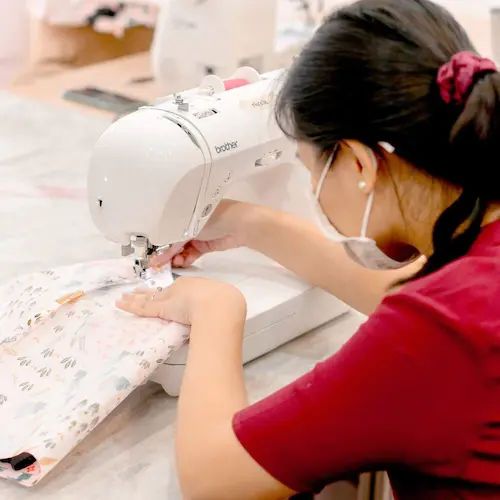Sewing Class Singapore

Sewing is a useful skill that allows you to make something beautiful and practical – from clothes and accessories to home accessories.
There are workshops in Singapore that cater to beginner to experienced audience, and onsite help by professionals provide you with tips or even design ideas.
Regardless of your skill, these classes are sure to enhance your sewing skills and perhaps provide you with new inspirations.
Why Take a Sewing Class in Singapore?
Sewing is not only essential but also creative. Learning to sew clothes will certainly save you money and moreover, will let you bring out your own style.
Picture your ability to repair your favorite clothes and pencil skirts or you can even combine a tutu skirt with a sweatshirt, or even design and produce your own line of dresses.
With sewing classes, training is one-to-one with individual and practical support provided by master teachers.
Overview of Sewing Classes in Singapore
In Singapore, you can find various sewing classes either for beginner sewer to advanced sewers in the world of fashion, home decor or accessories and they will be introduced in this article below.
Sewing is an important skill that all of us need to know because we wear clothes every day, and our home accessories bears a great deal of importance. If we are able to create, tweak, cut, clean, repair and fix those objects by ourselves, it will save a lot of time and money in the future.
What to Expect in a Sewing Class
What you will learn in an ordinary sewing class is how to sew the basic things, including: stroke a needle, sewing machine, the information about different kinds of fabric.
Beginners start by making easy clothes, such as reading the pattern; measure and cut the fabric, make a simple garment. Move on to more difficult techniques, such as hat making; making clothes, pattern dress and tailoring.
Factors to Consider When Choosing a Sewing Class
- Skill Level: Make sure the class is consistent with your current level of skill. Do you want a fundamentals class or something more advanced? Find one that is either at your level or will take you where you want to go.
- Location and Accessibility: Pick a class that is drivable, or that you can take using your feet on your own, or by transit. If so, you will really end up there.
- Class Size: With smaller class sizes, the chances of getting the chance to talk to a teacher on one-one-basis are much greater and this can be a much more pleasant experience for you, allowing you to learn how to sew more easily.
- Course Content and Specialization: Choose classes that teach you about a specific skill or topic in sewing, eg, basic sewing skills, dress making, embroidery and other topics that interest you.
- Instructor’s Experience: Ask about the experience and methodologies of the instructor. Look for instructor reviews or ask for recommendations by friends or family.
Best Sewing Class Singapore
1. Fashion Makerspace

In just a four-day beginners’ course at Fashion Makerspace, you can pick up the skill to make a cheongsam for your child. The course is a sewing class to make cheongsam for little girls with sewing machine.
The workshop let you learn to make a drawing, cut a cloth, build it together, and then to assemble the clothing. At the end of the sewing class on your fourth day, you will be done to make a little girl’s cheongsam. You can possibly give it to your little girl on the next Chinese New Year.
2. Sew Into It!

This is a great tutorial for taking a step up, and will teach you the basics of the skills required for patchwork and quilting, and will produce a 45×45 inch star-patterned piece which is perfect for a toddler or an infant. You’ll learn how to make all the fabrics ready and how to piece the heart and star shaped patchwork blocks.
3. Astitchworks

We’ve most likely been to the seamstress a lot of times for our clothing to be altered. After you’ve completed Astitchworks’ one-day course on how to alter your own clothes, those trips may become a thing of the past.
You’ll learn to alter by pinning and tacking and stitching, plus finishing up with all the extras that are required. And if you don’t know how to sew, don’t worry, this program is for beginners.
4. The General Company

We all love leather for its beauty and durability, but it’s also one of the most versatile materials around. This is why upgrading from basic textiles to the big boys of materials—leather—on your bag is a smart idea.
The staff at the local boutique The General Company, which are big on artisanal handmade products, organize special sessions on crafting leather.
5. The Cotton Shoppe

The shop is filled with a variety of personalised baby gifts, quilts, tote bags, and Japanese textiles. If you want to enhance your sewing and handicraft skills, check out their courses. Rotary cutting, patching, quilting, and putting are just a few of the workshops available.
The Cotton Shoppe also offers group and private sewing machine lessons, where supplies and equipment are provided.
6. Alisha Fashion and Dressmaking School

Apart from sewing courses in clothes, basic curtain making, Malay costumes, and more, they provide a diploma in Saree Blouse Making as well. For example, kids may participate in the children’s sewing classes, which include creative projects to make.
7. Jiji Jaja

Get this, the shop actually sells children’s clothing, the cutest Japanese fabrics, and home goods as well! You can browse the offerings online.
If you’ve been emboldened to craft your own creations after seeing the Thai crafts, there are sewing classes available as well to learn how to make your own traditional Japanese Jinbei (Japanese cotton smock/robe, traditionally worn by children in the south), tote bags, skirts and more.
Tips for Getting the Most Out of Your Sewing Class
- Practice Regularly: Try to do some practice of what you’ve learnt outside of class so that you can build a skillset and feel confident.
- Be Open to Feedback: Be open to suggestions. This is how you can gain knowledge from your instructor. Ask questions and receive helpful and constructive feedback to enhance your work techniques and projects.
- Ask Questions: If you don’t understand something, ask. When you clarify your doubts on the spot, you ensure that it won’t lead to bigger misunderstandings later on.
- Take Notes: Taking a few notes about major ideas, tips and techniques in class will keep it fresh in your mind so that when you review them with private practice, it is an easy session.
- Engage with Peers: Socialising with your classmates will feed your learning. Share a tip, give feedback, and learn from each other the experience.
Sewing Class Singapore
If you had the right sewing class, the rest would be easy. Different learners have different reasons for joining sewing classes.
There are beginners learning the basic skills to embark on sewing, medium-level learners sewing absolutely more niche areas.
Fortunately, learners in for their quality. In choosing this place to undertake sewing, you want to consider which class you can best utilise based on your skills in sewing, as well as how easy it is for you to attend such classes, the size of your group, and the instructor’s qualifications.
With regular practice, getting feedback from others and interacting with your peers, you can get the most out of the class. Good luck with your sewing!
Check out some of our other related articles and guides below:
- Best Workshops in Singapore (2025)
- Best Craft Workshops in Singapore to Check Out (2025)
- Best Art Jamming Singapore Workshops (2025)
- Best Terrarium Workshop Singapore (2025)
- Best Candle Making Workshops In Singapore (2025)
- Best Leather Making Workshops in Singapore (2025)
- Best Woodworking Workshops in Singapore (2025)
- Best Jewellery Making Workshops in Singapore (2025)
- Best Pottery Studios In Singapore (2025)
- Ultimate Guide To Soap Making Singapore (2025)
- Best Tufting Workshops in Singapore (2025)
- Best Photography Workshops in Singapore (2025)
Frequently Asked Questions (FAQ)
If you have any questions about sewing classes in Singapore, you can refer to the frequently asked questions (FAQ) about the best Sewing Classes in Singapore below:
What should I bring to a sewing class?
A standard kit (a length of fabric, scissors, needles and thread, perhaps a sewing machine if the class calls for it), basics (a measuring tape, pins or chalk, and a seam ripper) and perhaps a list of supplies provided by the instructor. Some classes, especially those teaching a skill rather than a specific object for a fee, provide their own stuff, so always check in advance. A notebook, and possibly a bag to carry everything in.
How long does it take to learn sewing?
How long it will take you to learn to sew depends on so many variables, the amount of time you’re willing to invest, the frequency with which you practice and the complexity of your projects, among other factors. You will hear the recommendation to begin with the simple, such as a pillowcase or a tote bag for a sense of the basics before graduating into progressively more complex projects over months or years, perhaps, culminating in the creation of garments with greater complexity to them. You become a sewer by never stopping the learning process. Start to learn and practice, and you will continue to improve.
Are there online sewing classes available in Singapore?
There are many options for online sewing classes available in Singapore, and most of the sewing schools and individual instructors offer virtual lessons. This is trending now as more people prefer to learn from their own home and schedule, which is a completely essential and great trend in today’s world. If you look online, there are options for virtual classes for even beginner-level tutorials to advanced workshops available – everything from how to sew a pillow to a suitable fabric for home decor. Some classes have pre-made patterns available for download, and you also have the option to join online forums where you can post pictures and questions about your progress for advice from fellow beginners.
Can children join sewing classes?
Definitely. Many schools that teach sewing offer a class especially for children. The classes may include simple projects for children to make as they learn, such as doll clothes, aprons, or bunnies. The projects could be fun and educational, as well as age appropriate. Instructors will probably use lesson plans and materials that are safe and easy for kids to handle. Some programs even offer parent-child sewing classes for parents who can learn along with their kids and make something together. Learning to sew can be a great hobby for kids as it teaches them patience, precision, as well as a feeling of accomplishment each time they finish a small project.







